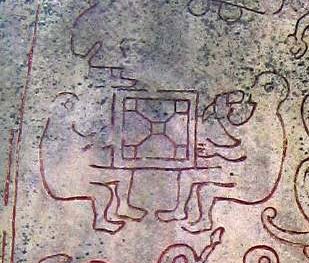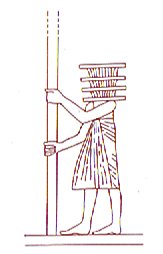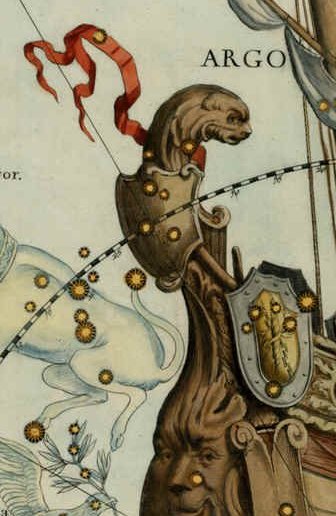|
R (Small
Washington Tablet)
26. → 121 - 95 Today is February 13 (AD 2025) and I am acutely aware of the fact that the Chorti diviners should soon be ready with their sacred task of selecting the proper stones. ... On February 9 the Chorti Ah K'in, 'diviners', begin the agricultural year. Both the 260-day cycle and the solar year are used in setting dates for religious and agricultural ceremonies, especially when those rituals fall at the same time in both calendars. The ceremony begins when the diviners go to a sacred spring where they choose five stones with the proper shape and color. These stones will mark the five positions of the sacred cosmogram created by the ritual ...
In fact, my attention was brought alive by a TV program I happened to watch in February 9, four days ago. The archeologists were jubilant, for they had finally, after 50 years of fruitless search (indeed they had given up), stumbled upon the Temple of Artemis. They had in vain searched in the vicinity of that city which the ancient writers had stated was very close to the Temple of Artemis. The reality was that it was indeed close to, but not very close to this city. They had relied on the written records which referred to a distance expressed by the number value of the Greek alphanumerical sign ζ: ... Zeta (uppercase Ζ, lowercase ζ; Greek: ζήτα ... is the sixth letter of the Greek alphabet. In the system of Greek numerals, it has a value of 7. It was derived from the Phoenician letter Zayin. Letters that arose from zeta include the Roman Z and Cyrillic З ... Zayin (also spelled Zain or Zayn or simply Zay) is the seventh letter of many Semitic abjads ... It represents the sound [z]. The Phoenician letter appears to be named after a sword or other weapon. (In Biblical Hebrew, 'Zayin' means sword, and the verb 'Lezayen' means to arm. In modern Hebrew, 'zayin' means penis and 'lezayen' is a vulgar term which generally means to perform sexual intercourse and is used in a similar fashion to the English word fuck, although the older meaning survives in 'maavak mezuyan' (armed struggle) and 'beton mezuyan' (armed, i.e., reinforced concrete). The Proto-Sinaitic glyph according to Brian Colless may have been called ziqq, based on a hieroglyph depicting a 'manacle'. To which we could add that 7 was the established sacred number for the Earth in contrast to the Sky (→ 'high five'). There were 7 months of summer and 12 - 7 = 5 months of winter.
In retrospect they could guess the mistake probably was due to the fact that anciently - before printed books - some monk tirelessly would have copied the work of some earlier monk and so on. Mistakes did happen, especially if the previous book was very old and hard to read. Such mistakes multiplied over time. The letter ζ looked similar to the letter ξ (for which I unfortunately have not as yet documented its Greek numerical value). But I remember my difficulties in properly locating the star letters (numbers) for Argo Navis. And especially ζ and ξ caused trouble, not only because I mistakenly did happen to document ξ instead of ζ (and vice versa), but also because my sources had different opinions about what letter belonged to what star. However, by relying on my old reliable astronomy book we can see the name Azmidiske for ξ and the name Naos for ζ:
... According to a variety of sources of the legend, the Argo was said to have been planned or constructed with the help of Athena. According to other legends it contained in its prow a magical piece of timber from the sacred forest of Dodona, which could speak and render prophecies. Argo Navis is the only one of the 48 constellations listed by the 2nd century astronomer Ptolemy that is no longer officially recognised as a constellation. It was unwieldy due to its enormous size: were it still considered a single constellation, it would be the largest of all. In 1752, the French astronomer Nicolas Louis de Lacaille subdivided it into Carina (the keel, or the hull, of the ship), Puppis (the poop deck), and Vela (the sails). When Argo Navis was split, its Bayer designations were also split. Carina has the α, β and ε, Vela has γ and δ, Puppis has ζ, and so on. The constellation Pyxis (the mariner's compass) occupies an area which in antiquity was considered part of Argo's mast (called Malus). However, Pyxis is not now considered part of Argo Navis, and its Bayer designations are separate from those of Carina, Puppis and Vela ... Which is reasonable because we know that ξ should imply a place pushed high up (aloft):
The declination for Azmidiske is 24° 44′ S and that for Naos is 39° 52′ S. That for Canopus is 52° 40′ S:
This allows us to perceive the place for Naos in the illustration of Hevelius. We only have to remember that his view has time running from left to right instead of the night time view with time running from right to left:
Canopus is the great star down on the Steering Oar on the starboard side. Azmindiske is high up on the Little Shield (= Azmidiske) and Naos has to be in between. We should look to the right of an imagined straight line up from Canopus to Azmidiske.
Naos is quite bright compared to the other stars close by and therefore it has to be the great star in the upper right corner of the shield, coming after the flowing hair up from the smiling Sun face. The picture inside the Naos shield seems to illustrate a kind of Tree, perhaps to be compared with the Mayan world tree which at midsummer merged with the King: ... I also learned that the kings embodied the ceiba at the moment it flowers to yield the sak-nik-nal, the 'white flowers', that are the souls of human beings. As the trees flowers to reproduce itself, so the kings flowered to reproduce the world ...
|


.jpg)

.jpg)

